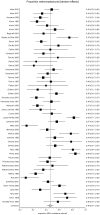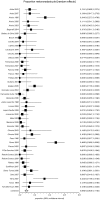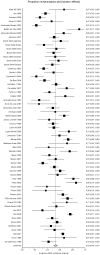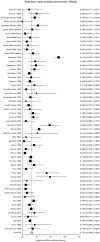Type-specific HPV prevalence in cervical cancer and high-grade lesions in Latin America and the Caribbean: systematic review and meta-analysis
- PMID: 21991313
- PMCID: PMC3186785
- DOI: 10.1371/journal.pone.0025493
Type-specific HPV prevalence in cervical cancer and high-grade lesions in Latin America and the Caribbean: systematic review and meta-analysis
Abstract
Background: Cervical cancer is a major public health problem in Latin America and the Caribbean (LA&C), showing some of the highest incidence and mortality rates worldwide. Information on HPV type distribution in high-grade cervical lesions (HSIL) and invasive cervical cancer (ICC) is crucial to predict the future impact of HPV16/18 vaccines and screening programmes, and to establish an appropriate post-vaccinal virologic surveillance. The aim was to assess the prevalence of HPV types in HSIL and ICC in studies in LA&C.
Methods and findings: We performed a systematic review, following the MOOSE guidelines for systematic reviews of observational studies, and the PRISMA statement for reporting systematic reviews and meta-analyses. Inclusion criteria were at least ten cases of HSIL/ICC, and HPV-type elicitation. The search, without language restrictions, was performed in MEDLINE, Cochrane Library, EMBASE, LILACS from inception date to December 2009, proceedings, reference lists and consulting experts. A meta-analysis was performed using arc-sine transformations to stabilize the variance of simple proportions. Seventy-nine studies from 18 countries were identified, including 2446 cases of HSIL and 5540 of ICC. Overall, 46.5% of HSIL cases harbored HPV 16 and 8.9% HPV18; in ICC, 53.2% of cases harbored HPV 16 and 13.2% HPV 18. The next five most common types, in decreasing frequency, were HPV 31, 58, 33, 45, and 52. Study's limitations comprise the cross-sectional design of most included studies and their inherent risk of bias, the lack of representativeness, and variations in the HPV type-specific sensitivity of different PCR protocols.
Conclusions: This study is the broadest summary of HPV type distribution in HSIL and ICC in LA&C to date. These data are essential for local decision makers regarding HPV screening and vaccination policies. Continued HPV surveillance would be useful, to assess the potential for changing type-specific HPV prevalence in the post-vaccination era in Latin America.
Conflict of interest statement
Figures








References
-
- Koutsky L. Epidemiology of genital human papillomavirus infection. Am J Med. 1997;102:3–8. - PubMed
-
- Ferlay J BF, Pisani P, Parkin DM. GLOBOCAN 2002: cancer incidence, mortality and prevalence worldwide. Lyon 2004
-
- Lewis M. Análisis de la situación del Cáncer Cervicouterino en América Latina y el Caribe. OPS Journal Washington DC 2004
-
- Parkin DM, Bray F, Ferlay J, Pisani P. Global Cancer Statistics, 2002. CA Cancer J Clin. 2005;55:74–108. - PubMed
Publication types
MeSH terms
LinkOut - more resources
Full Text Sources

